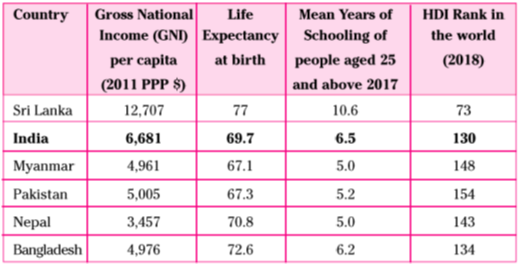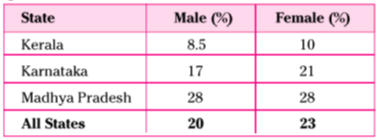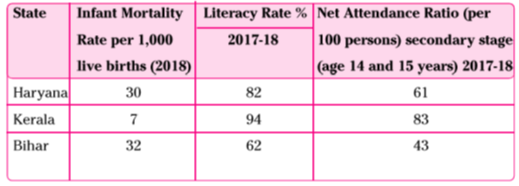Study Material
1. Development

1. Development of a country can generally be determined by
i) its per capita income ii) its average literacy level
iii) health status of its people iv) all the above
A. iv) all the above
2. Which of the following neighbouring countries has better performance in terms of human development than India ?
i) Bangladesh ii) Sri Lanka iii) Nepal iv) Pakistan
A. ii) Sri Lanka
3. Assume there are four families in a country. The average per capita income of these families is Rs. 5000. If the income of three families is Rs. 4000, Rs. 7000 and Rs. 3000 respectively, what is the income of the fourth family ?
i) Rs. 7500 ii) Rs. 3000 iii) Rs. 2000 iv) Rs. 6000
A. iv) Rs. 6000
Sol : Total income of four families = 5000 ´ 4 = ` 20,000
Total income of three families = 4000 + 7000 + 3000 = ` 14000
\ Income of the fourth family = 20,000 – 14,000 = ` 6,000
4. What is the main criterion used by the World Bank in classifying different countries ? What are the limitations of this criterion, if any ?
A. i) Per capita income is the main criterion used by the World Bank in classifying different countries.
ii) Countries with per capita income of US $ 12,056 per annum and above in 2017, are called rich countries and those with per capita income of US $ 955 or less are called low-income countries.
Limitations of this criterion are :
i) It doesn't show distribution of income.
ii) It also ignores other factors such as infant mortality rate, literacy level, healthcare, etc.
5. In what respects is the criterion used by the UNDP for measuring development different from the one used by the World Bank ?
A. The criterion used by the UNDP for measuring development is different from the one used by the World Bank in following ways :
i) The World Bank uses only one criterion, the per capita income but the UNDP uses many criteria which includes per capita income, health and education.
ii) UNDP ranks the countries on the basis of development whereas World Bank classifies them into three categories : rich countries, middle income countries and poor countries.
iii) UNDP has a broader framework to measure development whereas World Bank has a narrow framework.
6. Why do we use averages ? Are there any limitations to their use ? Illustrate with your own examples related to development.
A. i) We use averages as they are useful for comparing different quantities of the same category.
ii) This does not show the distribution of things between people.
iii) There are limitations of calculating averages because this does not give any information about the distribution of a thing between people.
iv) For example, suppose in a country, the annual income of a rickshaw puller is
Rs. 8,000 while an MNC employee earns an annual package of Rs.12,00,000. The average income of this country, therefore will be Rs. 6,05,000. Here actual income or status remains unknown.
v) It does not show the percentage of the poor in the population.
7. Kerala, with lower per capita income has a better human development ranking than Haryana. Hence, per capita income is not a useful criterion at all and should not be used to compare states. Do you agree ? Discuss.
A. Yes, we agree with the statement that per capita income is not a useful criterion at all to following reasons -
i) Kerala with a low per capita income has a better human development ranking than Haryana because Kerala has a high literacy rate, infant mortality rate, health facilities, etc.
ii) Per capita income is not the only indicator to measure state development, other indicators are also a must for the development of a state as a whole.
iii) Haryana has more per capita income than Kerala but Kerala has high ranking due to above mentioned factors.
8. Find out the present sources of energy that are used by the people in India. What could be the other possibilities fifty years from now ?
A. i) The present sources of energy that are used by the people of India are electricity, coal, crude oil, cow dung and solar energy.
ii) Fifty years from now, other possibilities could include ethanol, bio-diesel, nuclear energy and better utilisation of wind energy, especially with the imminent danger of oil resources running out.
9. Why is the issue of sustainability important for development ? (OR)
"The issue of sustainability is important for development". – Support.
A. i) Sustainable development refers to using natural resources in a manner so that they can be used by the present and future generations.
ii) The issue of sustainability is important for development because if natural resources are not sustained, then development will be hindered and will stop after some time.
iii) Sustainable development is important because it saves national budget.
iv) It fulfills the needs of the people.
v) It conserves natural resources, helps in coordination between the people and natural resources.
vi) The depleting resources of a country may ultimately result in a lack of development of the country.
10. "The Earth has enough resources to meet the needs of all but not enough to satisfy the greed of even one person". How is this statement relevant to the discussion of development ? Discuss.
A. i) This statement is relavant in terms of development as both resources and development go hand in hand.
ii) Maintaining the resources for future need is the core essence for sustainability of development.
iii) It is easy to fulfil basic needs whereas greed can never be satisfied and greed increases with every want fulfilled.
iv) Even if the earth has enough resources - renewable as well as non - renewable to satisfy everyone's needs, the resources should be used keeping in mind a vision to secure the environment and maintain a balance of production to avoid shortage or depletion of resources.
11. List a few examples of environmental degradation that you may have observed around you.
A. Few examples of environmental degradation are :
i) Deforestation
ii) Soil erosion
iii) Falling levels of ground water
iv) Depletion of the ozone layer and combustion from automobiles causing extreme air pollution.
v) Water pollution
vi) Throwing waste in river
vii) Use of chemical fertilizers and pesticides.
viii) Burning of coal and mineral oil.
12. For each of the items given in below table (1.6) find out which country is at the top and which is at the bottom ?
Some Data Regarding India and its Neighbours For 2019

A. 
13. The following table shows the proportion of adults (aged 15-49 years) whose BMI is below normal (BMI < 18.5 kg/m2) in India. It is based on a survey of various states for the year 2015 - 16. Look at the table and answer the following questions.

i) Compare the nutritional level of people in Kerala and Madhya Pradesh in both male & female.
ii) Can you guess why around one-fifth of people in the country are undernourished even though it is argued that there is enough food in the country ? Describe in your own words.
A. i) Nutritional level of Kerala is higher than that of the Madhya Pradesh.
ii) One-fifth of the population in the country are undernourished even though it is argued that there is enough food in the country because of the following reasons :
a) The disparity in the distribution of food grains by Public Distribution System (PDS).
b) Nutritions food cannot be afforded by the poor population in the country.
c) Educational backwardness of people results in unemployment because of which people cannot afford the basic necessity of food.
d) There is no proper distribution of ration at the fixed price stores.

Invite three different speakers to talk to you about the development of your region. Ask them all the questions that come to your mind. Discuss these ideas in groups. Each group should prepare a wall chart, giving reasons about ideas that you agree or do not agree with.
A. Here are some questions and ideas related to the development of Andhra Pradesh that you can discuss in groups. Here are three potential speakers and some questions we can ask them.
Speaker - 1
Q. 1. What are the key economic challenges Andhra Pradesh faces in terms of development ?
Q. 2. How has the state's economic development progressed in recent years and what are the main drivers of this growth ?
Q. 3. What role does industrialization play in the development of Andhra Pradesh, and what industries show the most promise for future growth ?
Q. 4. How can the government stimulate economic growth while ensuring it benefits of all sections of society ?
Speaker - 2
Q. 1. What are the social issues affecting the development of Andhra Pradesh ?
Q. 2. How can Andhra Pradesh ensure that development initiatives are sustainable and do not harm the environment or marginated communities ?
Speaker - 3
Q. 1. What is the government's vision for the development of Andhra Pradesh, and what policies have been implemented to achieve it ?
Q. 2. How does the government plan to balance economic development with social welfare programs ?
Ideas : Speaker - 1
i) Key economic challenges : Andhra Pradesh faces problems like joblessness, unequal development, and needs to expand its industries beyond farming.
ii) Andhra Pradesh has grown recently, mainly because of IT, manufacturing, and better infrastructure.
Ideas : Speaker - 2
i) Andhra Pradesh has problems with schools, healthcare, fairness for women, and poverty.
ii) The state can help by building better schools and hospitals, giving help to people who need it, and making sure men and women have the same rights. Development should be done in ways that don't hurt the environment.
Ideas : Speaker - 3
i) The government wants to make everything better, like the economy, people's lives, and infrastructure.
ii) They plan to do this by spending money on farming, factories, and helping poor people.
Question given in the Lesson
1. Let us try to imagine what development or progress is likely to mean to different persons listed in table 1.1. What are their aspirations ? You will find that some columns are partially filled. Try to complete the table. You can also add any other category of persons.
Developmental Goals of different categories of persons
| Category of Person | Developmental Goals / Aspirations |
| Landless rural labourers | More days of work and better wages; local school is able to provide quality education for their children; there is no social discrimination and they too can become leaders in the village. |
| Prosperous farmers from Punjab | Assured a high family income through higher support prices for their crops and through hardworking and cheap labourers; they should be able to settle their children abroad. |
| Farmers who depend only on rain for growing crops | |
| A rural woman from a land owning family | |
| Urban unemployed youth | |
| A boy from a rich urban family | |
| A girl from a rich urban family | She gets as much freedom as her brother and is able to decide what she wants to do in life. She is able to pursue her studies abroad. |
| An adivasi from Narmada valley |
A. Developmental Goals of different categories of persons
| Category of Person | Developmental Goals / Aspirations |
| Landless rural labourers | More days of work and better wages; local school is able to provide quality education for their children; there is no social discrimination and they too can become leaders in the village. |
| Prosperous farmers from Punjab | Assured a high family income through higher support prices for their crops and through hardworking and cheap labourers; they should be able to settle their children abroad. |
| Farmers who depend only on rain for growing crops | Increase in the artificial irrigation facilities, availability of HYV seeds, chemical fertilizers, pesticides and credit facilities to produce best results. |
| A rural woman from a land owning family | A high family income, equality of status, incomes and facilities within the family, availability of quality education and health facilities. |
| Urban unemployed youth | Increase in the employment opportunities, availability of vocational education and training. |
| A boy from a rich urban family | To get quality education and pursue his studies abroad. He requires capital to start his business. |
| A girl from a rich urban family | She gets as much freedom as her brother and is able to decide what she wants to do in life. She is able to pursue her studies abroad. |
| An adivasi from Narmada valley | Rehabilitation, regular work, better wages, education for their children, health facilities. |
| Urban casual labourers | Regular work, better wages, shelter, and vocational training. |
| People belonging to scheduled castes | Higher income, social quality, increase in job oppor-unities, quality education for their children, better health facilities. |
2. Based on data given in table give below (1.2) calculate the average income for both the countries.
Comparision of Two Countries

i) Will you be equally happy to live in both these countries ?
ii) Are both equally developed ?
A. i) No, because country B has not equitable distribution of income.
ii) No, country A has equitable distribution of income among its citizens. In country B, 4 out 5 citizens are poor.

1. Why do different persons have different notions of development ? Which of the following explanations is more important and why ?
a) Because people are different.
b) Because life situations of persons are different.
A. b) Because life situations of persons are different - This is because, people seek things that are most important for them, i.e., the thing that can fulfil their aspirations or desires.
2. Do the following two statements mean the same ? Justify your answer.
a) People have different developmental goals.
b) People have conflicting developmental goals.
A. No, the above two statements do not have the same meaning. This can be justified by the following example :
A boy from a rich urban family desires to get quality education and capital to invest. On the other hand, an activist from Narmada valley wants rehabilitation and regular work. These developmental goals are different but not conflicting.
3. Give some examples where factors other than income are important aspects of our lives.
A. i) In the case of rural woman, gender equality is more important than income.
ii) For Scheduled Castes and Tribes, social equality, self - confidence and self - esteem are more important factors than income.
iii) In the case of child labour proper education and freedom are more important factors than income.
iv) Job security is more important than more income for casual labourers.
4. Explain some of the important ideas of the above section in your own words.
A. i) People want more income through regular work, better wages, higher prices for their products.
ii) Besides income, people have other developmental goals also such as equal treatment in the society, freedom, security, proper education, shelter, healthcare and self-esteem.
iii) For development, people seek a mix of goals.
iv) If women engage in paid job, their dignity in the household and society increases.
v) A safe environment encourages women to take up variety of jobs or run a business.
Discuss the following situations.
5. Look at the picture. What should be the developmental goals for such an area ?
A.

i) Pucca houses should be built for slum.
ii) Water supply and sanitation facilities should be provided for them.
iii) Through regular work and better wages their income should be increased.
iv) Quality education should be provided for their children.
v) There should be no social discrimination against them.
6. Read this newspaper report and answer the questions that follow :
A vessel dumped 500 tonnes of liquid toxic wastes into open-air dumps in a city and in the surrounding sea. This happened in a city called Abidjan in Ivory Coast, a country in Africa. The fumes from the highly toxic waste caused nausea, skin rashes, fainting, diarrhoea etc. After a month seven persons were dead, twenty in hospital and twenty six thousand treated for symptoms of poisoning.
A multinational company dealing in petroleum and metals had contracted a local company of the Ivory Coast to dispose the toxic waste from its ship.
i) Who are the people who benefited and who did not ?
ii) What should be the developmental goal for this country ?
A. i) The local company owner and the multinational company benefited while a large number of innocent local people suffered from this act.
ii) The developmental goals for this country should be proper disposal of industrial wastes and better healthcare for the general people.
7. What can be some of the developmental goals for your village, town or locality ?
A. i) Employment opportunities should be created.
ii) Local school should be able to provide quality education for the children.
iii) Pucca houses should be built for the poor households.
iv) Primary health centres and hospitals should be opened.
v) There should be no existence of caste system and child labour.
vi) There should be no gender inequality within the family.
8. Give three examples where an average is used for comparing situations.
A. i) To compare the performance of cricket players, average is found out by dividing total runs scored by number of matches played excluding not outs.
ii) We find out average daily income to compare income of casual labourers.
iii) Average is used for comparing performance of students in an examination. The sum of marks obtained in each subject by a student is divided by the sum of the maximum marks in each subject and then multiplied with 100.
9. Why do you think average income is an important criterion for development ? Explain.
A. Countries have different populations, total income does not tell us what an average person is likely to earn. This is known by average income. So, average income, i.e., per capita income is an important criterion for development.
10. Besides size of per capita income, what other property of income is important in comparing two or more societies ?
A. Per capita income is useful for comparison. But it does not tell us how this income is distributed among people. So, apart from size of per capita income, equitable distribution of income is important in comparing two or more societies.
11. Suppose records show that the average income in a country has been increasing over a period of time. From this, can we conclude that all sections of the economy have become better ? Illustrate your answer with an example.
A. No, the increase in the average income of a country over a period does not mean that all sections of the economy have become better. Let us take an example from India has continuously been increasing since independence except for some particular years, but share of agriculture in total income of the economy has been decreasing. Even, today, the condition of Indian farmers is pitiable.
12. From the text, find out the per capita income level of about 10-15 low-income countries as per World Development Reports.
A. The per capita income level of low income countries was US $ 955 in 2017.
13. Write a paragraph on your notion of what should India do, or achieve, to become a developed country.
A. To become a developed country,
1) India should accelerate its GDP growth. Special emphasis should be given on agriculture and small scale industries.
2) There is urgent need to increase growth rate of agriculture sector by providing agricultural inputs, training, credit and marketing facilities to its farmers.
3) We should develop our infrastructrue, entrepreneurship, labour - intensive techniques, training, credit and marketing facilities and reduce corruption and red - tapism in government offices. Especially small scale industries should be encouraged.
14. Look at data in tables 1.3 and 1.4. Is Haryana ahead of Kerala in literacy rate, etc., as it is in terms of per capita income ?
TABLE 1.3 PER CAPITA INCOME OF SELECT STATES

TABLE 1.4 SOME COMPARATIVE DATA ON HARYANA, KERALA AND BIHAR

Sources : Economic survey 2020-21, P.A 157, National Sample Survey Organisation (Report No. 585), National statistical office, Government of India.
Explanation of some of the terms used in this table :
Infant Mortality Rate (or IMR) indicates the number of children that die before the age of one year as a proportion of 1000 live children born in that particular year.
Literacy Rage measures the proportion of literate population in the 7 and above age group.
Net Attendance Ratio is the total number of children of age group 14 and 15 years attending school as a percentage of total number of children in the same age group.
A. No, the per capita income of Haryana is nearly 10% more than that of Kerala but the literacy rate of Haryana (82%) is less than that of Kerala (94%).
15. Think of other examples where collective provision of goods and services is cheaper than individual provision.
A. There are a number of examples in life where collective provision of goods and services is better and cheaper than individual provision.
i) Hospital : Collective or public hospital will certainly be cheaper and better in comparison to the cost in availing medical facilities or a doctor at home. Also, it is not possible for every family to afford private medical facilities.
ii) Electricity : Collective electricity, i.e., electricity from State Electricity Boards or BSES in Delhi is cheaper than that of running generator in the house.
16. Does availability of good health and educational facilities depend only on amount of money spent by the government on these facilities ? What other factors could be relevant ?
A. i) No, though the availability of good health amd educational of good health and educational facilities depend heavily on amount of money spent by the government on these facilities but not only on these factors.
ii) The other relevant factors are :
a) Government's devotion towards these facilities.
b) Private participation in these areas, and
c) Public awareness about health and education.
17. In Tamil Nadu, 90 percent of the people living in rural areas use a ration shop, whereas in West Bengal only 35 percent of rural people do so. Where would people be better off and Why ?
A. The people of Tamil Nadu would be better off. This is because, here 90% of the rural people use ration shops. These people can get food grains, sugar, kerosene, oil etc. from ration shops at a price lower than the market price.
18. Example 1 : Groundwater in India
"Recent evidence suggests that the groundwater is under serious threat of overuse in many parts of the country. About 300 districts have reported a water level decline of over 4 metres during the past 20 years. Nearly one-third of the country is overusing their groundwater reserves. In another 25 years, 60 percent of the country would be doing the same if the present way of using this resource continues. Groundwater overuse is particularly found in the agriculturally prosperous regions of Punjab and Westren U.P., hard rock plateau areas of central and south India, some coastal areas and the rapidly growing urban settlements.
a) Why groundwater is overused ?
b) Can there be development without overuse ?
A. a) Now-a-days groundwater is highly overused because of many reasons, some of which are as follows :
i) Groundwater is a fresh water source and can be used for drinking purpose. It is actually over exploited in urban areas for domestic use and drinking purpose.
ii) Groundwater is extensively used for irrigation purpose, especially in North India. Here, most farmers have their own wells and tubewells in their farms for irrigation to increase their production.
iii) Post - independent India witnessed intensive industrialization and urbanization. Both these factors have made the matter worse by exerting pressure on existing freshwater resources.
b) Yes, definitely development is possible without overuse. This is what we know as "sustainable development". Sustainable development uses today resources judiciously, so that the future generation too has their fair share of resources. Promoting sustainable development can do lots to prevent groundwater levels.

The table gives an estimate of reserves of crude oil (column 1). More important, it also tells us for how many years the stock of crude oil will last if people continue to extract it at the present rate. The reserves would last only 50 years more. This is for the world as a whole. However, different countries face different situations. Countries like India depend on importing oil from abroad because they do not have enough stocks of their own. If prices of oil increase this becomes a burden for everyone. There are countries like USA which have low reserves and hence want to secure oil through military or economic power.
The question of sustainability of development raises many fundamentally new issues about the nature and process of development.
a) Is crude oil essential for the development process in a country ? Discuss.
A. Yes, crude oil essential for the development process in a country because of the following reasons -
i) Most of the industries and factory depend on crude oil.
ii) 97% of energy required for transportation provided by crude oil.
iii) There are also many products such as diesel, jet fuel, LPG, kerosene etc, that we get from crude oil and it is essential for development.
b) India has to import crude oil. What problems do you anticipate for the country looking at the above situation ?
A. The problems related to import of crude oil in India are as follows :
i) Value of rupee plays very important role in world market.
ii) Imports are expensive than exports (India exports petroleum to other countries)
iii) Rising crude oil prices.
